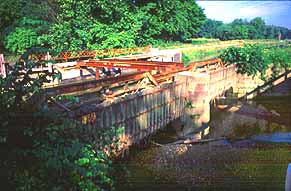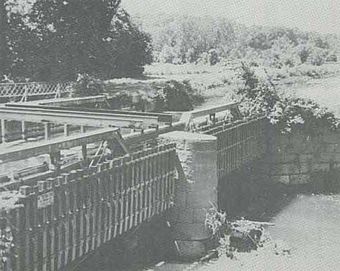Tinkers Creek Aqueduct facts for kids
Quick facts for kids Tinkers Creek Aqueduct |
|
|---|---|
 |
|
| Coordinates | 41°21′53.5″N 81°36′31.7″W / 41.364861°N 81.608806°W Elevation: 610 feet (190 m) |
| Carries | Ohio and Erie Canal |
| Crosses | Tinkers Creek (Cuyahoga River) |
| Locale | Canal Road and Tinkers Creek Road, Valley View, Cuyahoga County, Ohio |
| Maintained by | National Park Service, Cuyahoga Valley National Park |
| Characteristics | |
| Material | wood deck and sides, steel trusses over Ashlar-sandstone piers |
| Total length | Overall (including approaches): 90 feet (27 m) Each span: about 40 feet (12 m) |
| Width | Interior: 22 feet (6.7 m) |
| Number of spans | 2 |
| Piers in water | 1 |
| Load limit | 16,500 pounds (7,500 kg) per running 1 foot (0.30 m) |
| Clearance above | Unlimited |
| Clearance below | 0 feet (0 m) |
| History | |
| Construction begin | 1826 |
| Construction end | 1827 Re-built: 1845 and 1905 |
| Opened | 1827 until 1913 flood subsequent disuse 2007-? reconstruction project |
|
Tinkers Creek Aqueduct
|
|
|
U.S. National Historic Landmark District
Contributing Property |
|

Tinkers Creek Aqueduct
|
|
| Location | Valley View, Cuyahoga County, Ohio |
| Area | less than one acre |
| Built | 1825-1827; rebuilt 1845 and 1905 |
| Part of | Ohio and Erie Canal (ID66000607) |
| MPS | Ohio and Erie Canal TR |
| NRHP reference No. | 79000296 |
| Significant dates | |
| Added to NRHP | December 11, 1979 |
| Designated NHLDCP | November 13, 1966 |
The Tinkers Creek Aqueduct is a special kind of bridge that was built to carry the Ohio and Erie Canal over Tinkers Creek. This creek flows into the Cuyahoga River in Valley View, Ohio. It's one of the few remaining aqueducts from the Ohio and Erie Canal.
Contents
What is an Aqueduct?
An aqueduct is like a bridge for water. It allows a canal, which is a human-made waterway, to cross over a valley or another river. The Tinkers Creek Aqueduct helped boats on the Ohio and Erie Canal continue their journey without interruption.
A Bridge for Water
The original aqueduct was made of wood planks, steel supports, and Ashlar-sandstone blocks. It was built in 1827. Imagine a giant wooden trough filled with water, held up by strong stone pillars and steel beams. This allowed canal boats to float across the creek below.
A Long History
The first Tinkers Creek Aqueduct was built between 1825 and 1827. It was located a bit south of where the aqueduct stands today. However, floods from the Cuyahoga River and Tinkers Creek often damaged it. Because of this, new versions of the aqueduct had to be built in 1845 and again in 1905.
Today, the Tinkers Creek Aqueduct is the only one left of the four original aqueducts in the Cuyahoga Valley. Other aqueducts like Furnace Run and Peninsula are gone. The Mill Creek Aqueduct is the only one that still carries water from the Ohio and Erie Canal.
Why is it Important?
The Tinkers Creek Aqueduct is a very important historical structure. It was recognized as part of a National Historic Landmark district in 1966. Later, in 1979, it was also listed separately on the National Register of Historic Places. This means it's a special place that helps us understand the history of transportation and engineering in the United States. It is now managed by the National Park Service as part of the Cuyahoga Valley National Park.
Facing Challenges: Floods and Repairs
Over many years, the aqueduct faced a lot of wear and tear from floods and weather. After 102 years, the structure was removed in 2007 because it was in very poor condition. The area around the aqueduct is often flooded by the Cuyahoga River and Tinkers Creek.
The National Park Service has been working on a project to rebuild the aqueduct. The goal is to create a new structure using modern materials that can withstand future floods. This will help preserve the history of the Ohio and Erie Canal for future generations.

